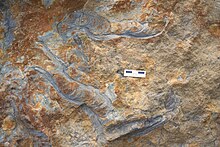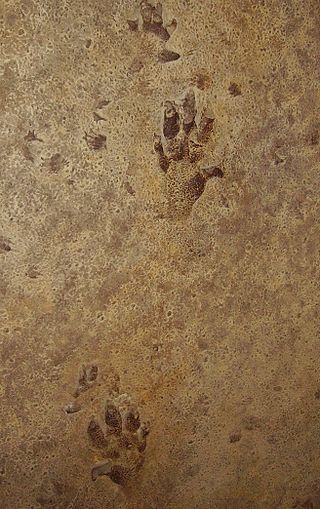
A trace fossil, also known as an ichnofossil, is a fossil record of biological activity by lifeforms but not the preserved remains of the organism itself. Trace fossils contrast with body fossils, which are the fossilized remains of parts of organisms' bodies, usually altered by later chemical activity or mineralization. The study of such trace fossils is ichnology and is the work of ichnologists.
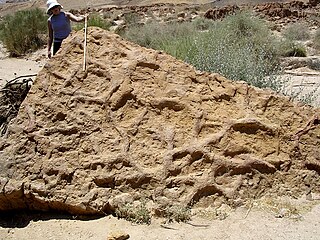
Thalassinoides is an ichnogenus of trace fossil used to refer to "dichotomously or T-branched boxworks, mazes and shafts, unlined and unornamented". Facies of Thalassinoides increased suddenly in abundance at the beginning of the Mesozoic. Such burrows are made by a number of organisms, including the sea anemone Cerianthus, Balanoglossus and fishes, but are most closely associated with decapod crustaceans of the (former) infraorder Thalassinidea.

The Ischigualasto Formation is a Late Triassic geological formation in the Ischigualasto-Villa Unión Basin of southwestern La Rioja Province and northeastern San Juan Province in northwestern Argentina. The formation dates to the late Carnian and early Norian stages of the Late Triassic, according to radiometric dating of ash beds.
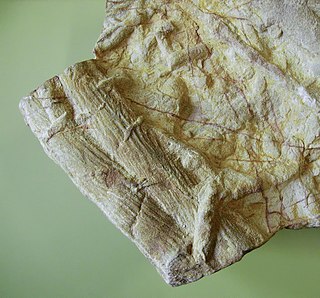
Cruziana is a trace fossil consisting of elongate, bilobed, approximately bilaterally symmetrical burrows, usually preserved along bedding planes, with a sculpture of repeated striations that are mostly oblique to the long dimension. It is found in marine and freshwater sediments. It first appears in upper Fortunian rocks of northern Iran and northern Norway. Cruziana has been extensively studied because it has uses in biostratigraphy, and because the traces can reveal many aspects of their makers' behavior.

Carbonate hardgrounds are surfaces of synsedimentarily cemented carbonate layers that have been exposed on the seafloor. A hardground is essentially, then, a lithified seafloor. Ancient hardgrounds are found in limestone sequences and distinguished from later-lithified sediments by evidence of exposure to normal marine waters. This evidence can consist of encrusting marine organisms, borings of organisms produced through bioerosion, early marine calcite cements, or extensive surfaces mineralized by iron oxides or calcium phosphates. Modern hardgrounds are usually detected by sounding in shallow water or through remote sensing techniques like side-scan sonar.

Sedimentary structures include all kinds of features in sediments and sedimentary rocks, formed at the time of deposition.

Skolithos is a common trace fossil ichnogenus that is, or was originally, an approximately vertical cylindrical burrow with a distinct lining. It was produced globally by a variety of organisms, mostly in shallow marine environments, and appears as linear features in sedimentary rocks.
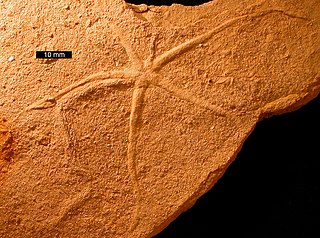
Asteriacites is the name given to five-rayed trace fossils found in marine sedimentary rocks. They record the burrows of ophiuroid and asteroid sea stars on the sea floor. Asteriacites are found in European and American rocks, from the Ordovician period onwards, and are especially numerous in the Triassic and Jurassic systems.
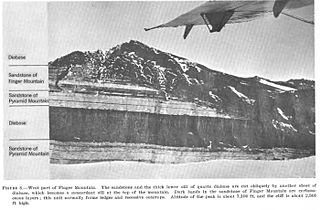
The Beacon Supergroup is a geological formation exposed in Antarctica and deposited from the Devonian to the Triassic. The unit was originally described as either a formation or sandstone, and upgraded to group and supergroup as time passed. It contains a sandy member known as the Beacon Heights Orthoquartzite.
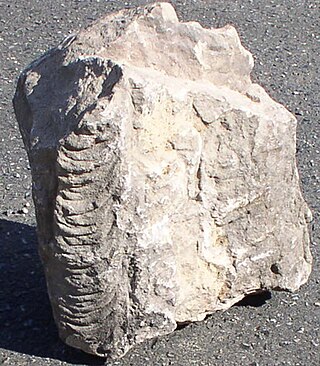
Diplocraterion is an ichnogenus describing vertical U-shaped burrows having a spreite between the two limbs of the U. The spreite of an individual Diplocraterion trace can be either protrusive or retrusive. Some ichnospecies have both types. The presence/absence of funnel-shaped openings should not be used as an ichnotaxobase due to the high probability that the upper portions of the trace may have been eroded away. Observation of the orientation of Diplocraterion in the field is frequently used to determine the way up of rock strata at outcrop.
The Triassic Lockatong Formation is a mapped bedrock unit in Pennsylvania, New Jersey, and New York. It is named after the Lockatong Creek in Hunterdon County, New Jersey.

Komlosaurus is an ichnogenus of theropod dinosaur from the Early Jurassic of Baranya, Hungary. The type species, Komlosaurus carbonis, was described by Kordos in 1983. The type remains come from the Mecsek Coal Formation, from the Middle Hettangian to the Early Sinemurian, and comprise several footprints.

The Cleveland Ironstone Formation is a sequence of marine ironstone seams interbedded with shale and siltstone units which collectively form a part of the Lower Jurassic System of rocks underlying Cleveland in North Yorkshire. Exploitation of the ironstone seams became a major driving force behind the industrialisation of the Teesside district during the mid- to late-1800s.

Tanytrachelos is an extinct genus of tanystropheid archosauromorph reptile from the Late Triassic of the eastern United States. It contains a single species, Tanytrachelos ahynis, which is known from several hundred fossil specimens preserved in the Solite Quarry in Cascade, Virginia. Abundant fossils of Tanytrachelos are found in a series of lakebed sediments that were deposited over the course of about 350 thousand years in a lake which existed approximately 230 million years ago. Some fossils are very well-preserved and include the remains of soft tissues. Tanytrachelos is the most likely trackmaker of the ichnogenus Gwyneddichnium.

San Cassiano Formation (Anisian-Carnian) is a geologic formation located on the Southern Alps in the Dolomites. These Triassic dolomites are considered to be a classic example of ancient carbonate platforms. As the allochthonous elements in the Shale strata show a good preservation, fossils and microbialites contained in these elements are useful in detailed geochemical analyses.

Spreite, meaning leaf-blade in German is a stacked, curved, layered structure that is characteristic of certain trace fossils. They are formed by invertebrate organisms tunneling back and forth through sediment in search of food. The organism moves perpendicularly just enough at the start of each back-and-forth pass so that it avoids reworking a previously tunneled area, thereby ensuring that it only makes feeding passes through fresh, unworked sediment.
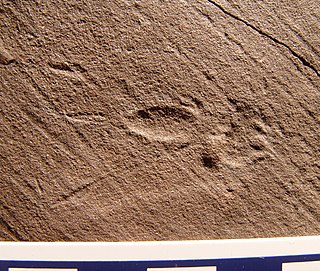
Cheliceratichnus, meaning trace of a chelicerate arthropod, is an ichnogenus erected for a body imprint discovered in the Lower Jurassic East Berlin Formation of Holyoke, Massachusetts. The specimen is now housed at the Springfield Science Museum in Springfield, Massachusetts. Considering that only a single specimen was found, the ichnogenus is monospecific, with the species name lockleyi honoring paleontologist and ichnologist Martin Lockley. In trace fossil classification schemes based on behavior, the body imprint is considered a cubichnion, or resting trace. Cheliceratichnus lockleyi exhibits the tagma characteristic of arthropods, with the trace divided into anterior, central, and posterior regions. Dalman and Lucas (2015) interpreted these regions as imprints of the chelicerae, prosoma, and opisthosoma, respectively, of a chelicerate arthropod. Additionally, imprints of the animal's legs and telson were identified. These authors noted that, in general, the pattern of the trace was similar to the body plan of the Solifugae, or camel spiders, but also noted that the presence of a telson imprint rules out that group because these animals lack telsons. Consequently, they attributed the trace to a solifuge-like arthropod without being more committal on what made it. In addition to the body imprint, the animal produced a trackway, called Acanthichnus cursorius, leading away from the body imprint, which demonstrates that the animal was alive at the time its body imprinted the sediment.

Pentasaurus is an extinct genus of dicynodont of the family Stahleckeriidae, closely related to the well known Placerias. It was found in the Lower Elliot Formation of South Africa, dated to the Norian of the Late Triassic period. The genus contains the type and only species, Pentasaurus goggai. Pentasaurus is named after the ichnogenus Pentasauropus, fossil footprints that were originally described from the lower Elliot Formation in 1970 decades before the body fossils of Pentasaurus itself were recognised. Pentasauropus footprints were likely made by dicynodonts, and in South Africa Pentasaurus itself was the likely trackmaker. The name reflects the fact that a large dicynodont was predicted to have existed in the lower Elliot Formation before any body fossils were recognised, and so Pentasaurus was named after its probable footprints. This is a reversal of the more typical occurrence where fossil footprints are named after their presumed trackmakers. The name of the species honours its collector Alfred Brown, nicknamed "Gogga", which means "bug" in Afrikaans.
This article records new taxa of trace fossils of every kind that are scheduled to be described during the year 2019, as well as other significant discoveries and events related to trace fossil paleontology that are scheduled to occur in the year 2019.
The Timezgadiouine Formation, sometimes spelled as the Timesgadiouine Formation, is a Triassic geological formation in the Argana Basin of Morocco. It is a succession of red bed sediments spanning from the Olenekian to at least the Carnian, encompassing members T3 to T5 of the Argana Group. It is preceded by the Permian Ikakern Formation and succeeded by the Late Triassic Bigoudine Formation.
